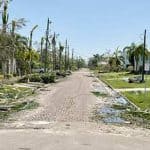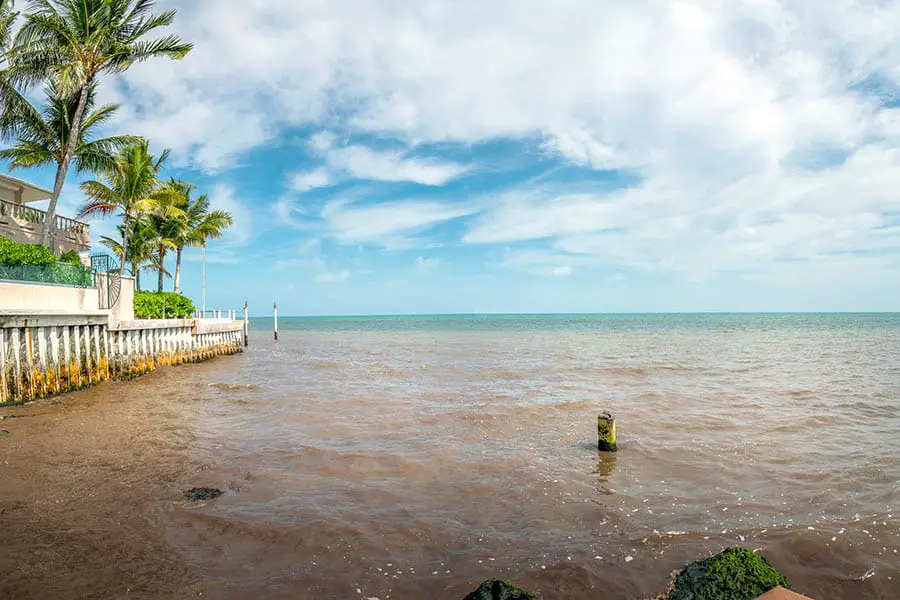
One of Florida’s biggest attractions is the water. Whether you like to swim, fish, boat, parasail, relax on the beach or take a walk down the pier, most everybody wants to be near the water in Florida. But what about red tide – is red tide a problem in Florida?
Red tide occurs about once a year in Florida, usually in the late summer months. Red tide is a problem that can lead to fish kills, reductions in tourism, and damage to the marine ecosystem. Despite this, there are signs of hope as scientists actively work on the red tide problem.
But what even is red tide? Is it really red? How can it be such a big problem, and what can be done to fix it? Discover the answers to these questions so you can plan accordingly.
Red Tide: Imbalance in the Ecosystem
So what exactly is red tide? Red tide is a phenomenon that results when an abnormal algal bloom occurs in ocean waters. While there are always algae species in the water, the results can be disastrous when they get thrown out of balance. As anybody who has had an aquarium or lived near a lake can tell you, algae bloom with surprising speed and can be rather difficult to combat.
Several different types of algae contribute to red tide. The most important species is known by the scientific name Karenia Brevis. Usually, brevis lives in the Gulf of Mexico in relatively small concentrations. However, when circumstances are just right, the brevis population can explode into a harmful algae bloom.
When brevis becomes an algae bloom, it releases a neurotoxin known as brevetoxin. Brevetoxin is poisonous to many different marine species and is also toxic to human beings. Exposure on the skin, in the eyes, by ingestion of seawater, or even by inhaling air that has brevetoxin can result in mild illness. Symptoms of brevetoxin exposure include gastric upset, paresthesias (burning sensations), vertigo, cough, bronchospasm, and a lack of muscle coordination.
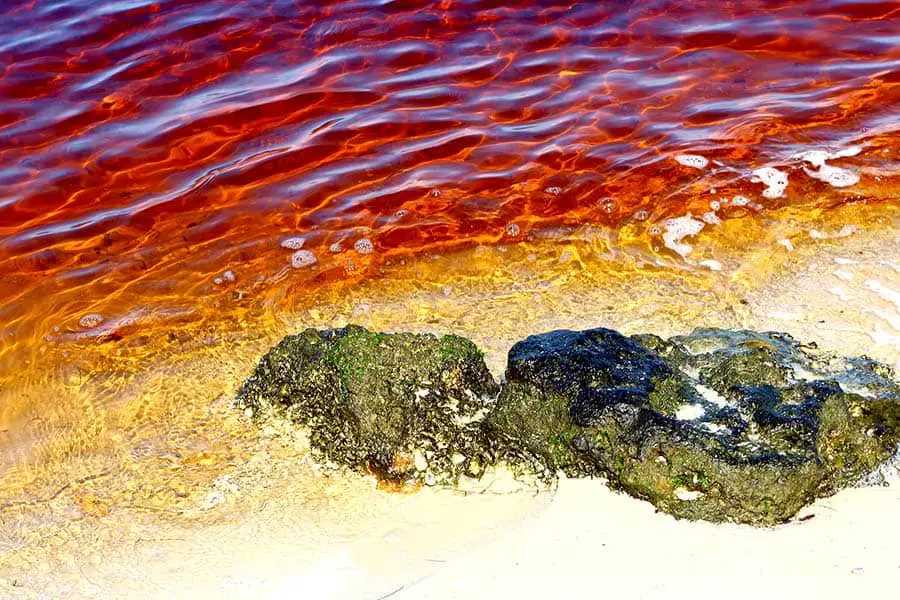
So what causes brevis to bloom? The short answer is: food. Like any other kind of life, algal organisms respond well to increased amounts of food in their ecosystem. So when the supply of delicious algae chow increases, the algae thrive.
There are several major sources of food that can lead to algae blooms. The first is food derived from human activities. For example, when people in peninsular Florida fertilize their lawns and crops or when large industrial operations discharge fertilizer or fertilizer components, the fertilizer ends up in the ocean.
In addition, heavy rains or tropical storms will often generate large plumes of runoff that eventually end up in the ocean and feed the algae.
The second major source of food that can lead to algae blooms is a species known as Trichodesmium. When the trade winds blow Saharan dust across the ocean to Florida, Trichodesmium feeds and grows. When these organisms die, brevis consumes them, and this can lead to an algae bloom.
Florida’s sugarcane and cattle industries generate a lot of runoff that contains the very nutrients that brevis needs to survive. These nutrients end up in lakes and streams, where they flow to the ocean and lead to the development of red tide. Finally, aging infrastructure has caused the occasional release of sewage into the ocean, which provides valuable nutrients for brevis.
Phenomenal Florida Fun Fact: Researchers in Florida are testing a process that uses ozone to kill brevis. During a 5-day trial in Boca Grande, the scientists successfully eradicated brevis and its associated toxins from a local canal.
Why is it Called a Red Tide?
Red tide gets its name from the rusty, ruddy discoloration that occurs in the water when brevis blooms. As we mentioned, brevis is the most problematic organism, but red tide also involves a number of other algal species. Many of these species have brown or red pigments that show clearly in the water when an algae bloom is occurring. So, during a red tide event, you can see swirls of brown, rust, and red colors in the waters, especially if you are closer to shore.
How Often is the Red Tide in Florida?
Red tide happens about once a year in Florida. Depending on specific circumstances, Florida may experience smaller red tide events here and there. The organisms responsible for red tide are native and naturally occurring parts of the ocean ecosystem that happen to be thrown out of balance by sudden surges in the availability of food, which often coincides with heavy rain events that flush runoff out of the inland waterways to the ocean.
What Months Does the Red Tide Occur in Florida?
Red tide generally occurs in the late summer and early autumn months. At the time of this writing, in July, there is a red tide event happening in Tampa Bay. You can get updates from Florida Fish and Wildlife Conservation Commission. These summer events are likely tied to the heavier summer rains that flush the waterways into the Gulf of Mexico and the Atlantic Ocean.
Other Posts of Interest
- Why Are The Florida Keys Called Keys And Not Islands?
- Does Florida Have Pythons?
- Where Is The Best Place To See Wild Flamingos In Florida?
- What Is Sun’ n Fun? (Plus Tips For Attending)
Can You Swim in a Red Tide?
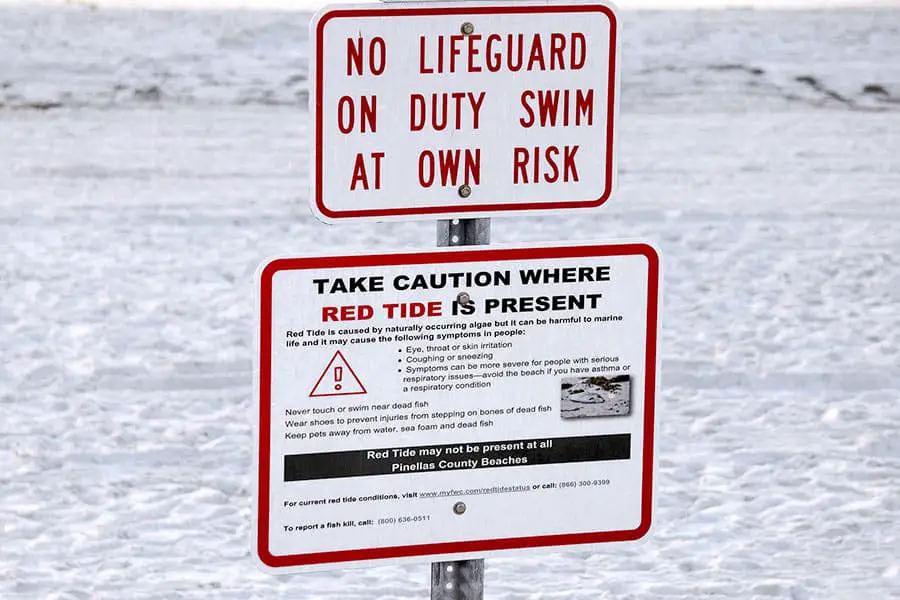
While it is not advisable, you can swim during red tide. However, you should be wary of potential effects from the tide. When waves crash and break, they can aerosolize the brevetoxin, which causes a burning and itching sensation that some people have compared to being pepper sprayed. Red tide can also cause skin and eye irritation and could cause trouble breathing in people who have asthma or other breathing/respiratory disorders. So your best bet for a great day at the beach is to wait until the situation resolves itself.
Red tide also produces fish kills. It is not uncommon to see large amounts of dead fish washing ashore during a red tide event. You should stay away from any fish kills, as the natural decomposition of the fish can attract other harmful bacteria to the area.
Where is the Red Tide in Florida?
Red tide can occur in any oceanic area of Florida, but the most common place to see red tide is on the southwestern coast of Florida near the Tampa Bay Area. This occurrence is due to the patterns of water runoff that discharge into the Gulf of Mexico. So while you can find red tide on Florida’s Atlantic coast, it is more common in the Gulf of Mexico.
What Beaches in Florida are Affected by Red Tide?
Unfortunately, the most common areas in Florida for algae blooms and red tide are also some of the best beaches in the state. The Florida Fish & Wildlife Commission reports that the area most prone to red tides is the stretch of the Gulf coast between Clearwater and Sanibel. This area encompasses much of Florida’s renowned Gulf Coast, including beaches like Clearwater Beach.
Since this region is heavily reliant on the tourism economy, red tides can be disastrous to the local economy. A 2018 report from the Tampa Bay Regional Planning Council found that red tides can have an impact of almost $60 million on the local economy. Red tides discourage the throngs of tourists who would typically be enjoying marine activities like boating, fishing, swimming, or beachgoing; their absence significantly affects local businesses.
What Gets Rid of the Red Tide?
The short answer to this question is: time. Red tide thrives for a while, and once it has depleted its food sources, it dies back down. This answer, however, is not an especially satisfying answer to the millions of people who depend on Florida’s coastline for their livelihoods, recreation, and residency. So, is there truly no means to get rid of red tide?
Fortunately, scientists are hard at work finding a solution. Promising research is being done that might lead to a way to get rid of red tide. Different ideas being tested include:
- Zapping brevis-contaminated waters with ozone.
- Developing “living docks” of filter feeders (think barnacles) to filter contaminated waters.
- Using special ionized clays to encapsulate and sink brevis.
Does Red Tide Kill Fish?
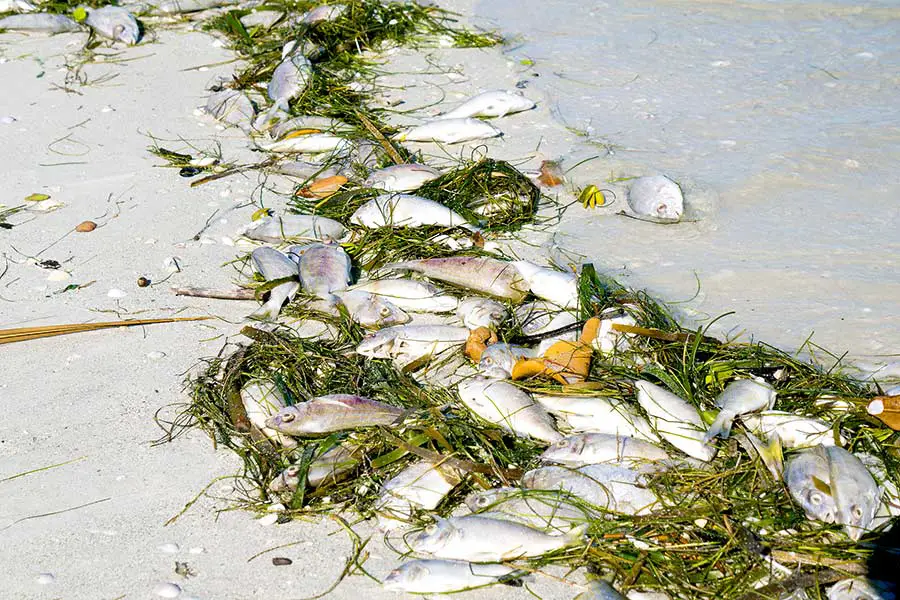
As noted earlier, red tide does often lead to fish kills. While brevetoxin might not be lethal to human beings, it is highly lethal to fish and other forms of marine life. It is not unusual for beachgoers to find scores of dead fish during a red tide. Marine mammals like manatees and dolphins, as well as seabirds and turtles, can also be killed by red tide.
Can Red Tide Kill Humans?
There have been no deaths associated with red tide in Florida. However, swimming or being in contact with red tide can lead to skin, eye, and respiratory irritation. In addition, it could potentially lead to gastric symptoms like those of food poisoning, and eating a fish killed by red tide will give you food poisoning.
Although it is unlikely to trigger an event severe enough to require hospitalization, asthmatics and people with breathing problems should avoid red tide. In addition, swimming during red tide is not one of the best experiences you could have, so you might want to forego it until the red tide event resolves itself or choose to go to an unaffected beach.
A daily sampling map is available to help you stay up-to-date on red tide statistics throughout the state.
Red Tide: A Problem, But Not An Apocalypse
There’s no denying that red tide is sometimes a problem for Florida. But there are many signs of hope that this problem will find a resolution. Scientists are working hard to find ways to reduce or eliminate the red tide, an issue that is being tackled on multiple different fronts.
Don’t let red tide scare you away from Florida. Even during red tide events, the conditions at the beach change daily: if you can’t go to Clearwater Beach, you might be able to head to Indian Shores or take a trip toward Sarasota or Venice. Or you could enjoy some of the Tampa Bay Area’s great amenities. So while red tide is an unfortunate Florida reality, take it from me: there’s still nowhere else you’d rather be.


